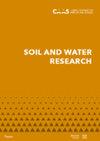印度尼尔吉里山农业流域土壤漂移动力学中人类进化过程的阴影
IF 1.7
4区 农林科学
Q4 SOIL SCIENCE
引用次数: 4
摘要
Nilgiri生物圈是重要的集水区之一,对Udhagamandalam的一个小型农业流域进行了分析,以表明有必要通过减少土壤侵蚀来改善农业。在这项研究中,使用陆地卫星图像进行了土地利用和土地覆盖分类,以突出1981年至2019年间发生的变化。本研究采用改良的通用土壤流失方程(RUSLE)方法和地理信息系统(GIS)来确定塔米尔纳杜Nilgiri山Sillahala流域的土壤侵蚀脆弱性。这项研究将有助于通过适当的农业规划和侵蚀管理促进流域的经济发展。本研究的重点是估算年均土壤损失,并利用RUSLE方法和GIS将土壤损失的空间分布分类为地图。为了估计研究区域的年均土壤损失,以栅格数据格式计算了降雨侵蚀力(R)、土壤可蚀性(K)、边坡长度和坡度(LS)、覆盖管理(C)和保护实践(P)等RUSLE因素的GIS层。研究区1981~19901991~2000年、2001~2010年、2011~2019年的土壤总损失和年均土壤损失分别为0.2、0.254、30、35万t/年和31.33、37.78、46.7、51.89 t/公顷/年。根据粮农组织的指导方针,土壤侵蚀率被划分为不同的类别,编制这份严重程度分类图是为了确定脆弱地区。本文章由计算机程序翻译,如有差异,请以英文原文为准。
The overshadow of the human evolvement process in the dynamics of soil drift of an agricultural watershed in Nilgiri Hills, India
The Nilgiri Biosphere, being one of the critical catchments, a small agricultural watershed of Udhagamandalam has been analysed to show the need to improve the agriculture by reducing the soil erosion. For this study, the land use and land cover classification was undertaken using Landsat images to highlight the changes that have occurred between 1981 and 2019. The Revised Universal Soil Loss Equation (RUSLE) method and the Geographic Information System (GIS) was used in this study to determine the soil erosion vulnerability of Sillahalla watershed in the Nilgiri Hills in Tamilnadu. This study will help to promote the economic development of the watershed with proper agricultural planning and erosion management. This study focuses on the estimation of the average annual soil loss and to classify the spatial distribution of the soil loss as a map with the RUSLE method and GIS. To estimate the average annual soil loss of the study area, GIS layers of the RUSLE factors like rainfall erosivity (R), soil erodibility (K), slope length and steepness (LS), cover management (C) and conservation practice (P) were computed in a raster data format. The total soil loss and average annual soil loss of the study area for 1981–1990,1991–2000, 2001–2010, 2011–2019 were found to be 0.2, 0.254, 0.3, 0.35 million t/year and 31.33, 37.78, 46.7, 51.89 t/ha/year, respectively. The soil erosion rate is classified into different classes as per the FAO guidelines and this severity classification map was prepared to identify the vulnerable areas.
求助全文
通过发布文献求助,成功后即可免费获取论文全文。
去求助
来源期刊

Soil and Water Research
Water resources, Soil Science, Agriculture-WATER RESOURCES
CiteScore
4.60
自引率
0.00%
发文量
26
审稿时长
>12 weeks
期刊介绍:
An international peer-reviewed journal published under the auspices of the Czech Academy of Agricultural Sciences and financed by the Ministry of Agriculture of the Czech Republic. Published since 2006.
Thematic: original papers, short communications and critical reviews from all fields of science and engineering related to soil and water and their interactions in natural and man-modified landscapes, with a particular focus on agricultural land use. The fields encompassed include, but are not limited to, the basic and applied soil science, soil hydrology, irrigation and drainage of lands, hydrology, management and revitalisation of small water streams and small water reservoirs, including fishponds, soil erosion research and control, drought and flood control, wetland restoration and protection, surface and ground water protection in therms of their quantity and quality.
 求助内容:
求助内容: 应助结果提醒方式:
应助结果提醒方式:


